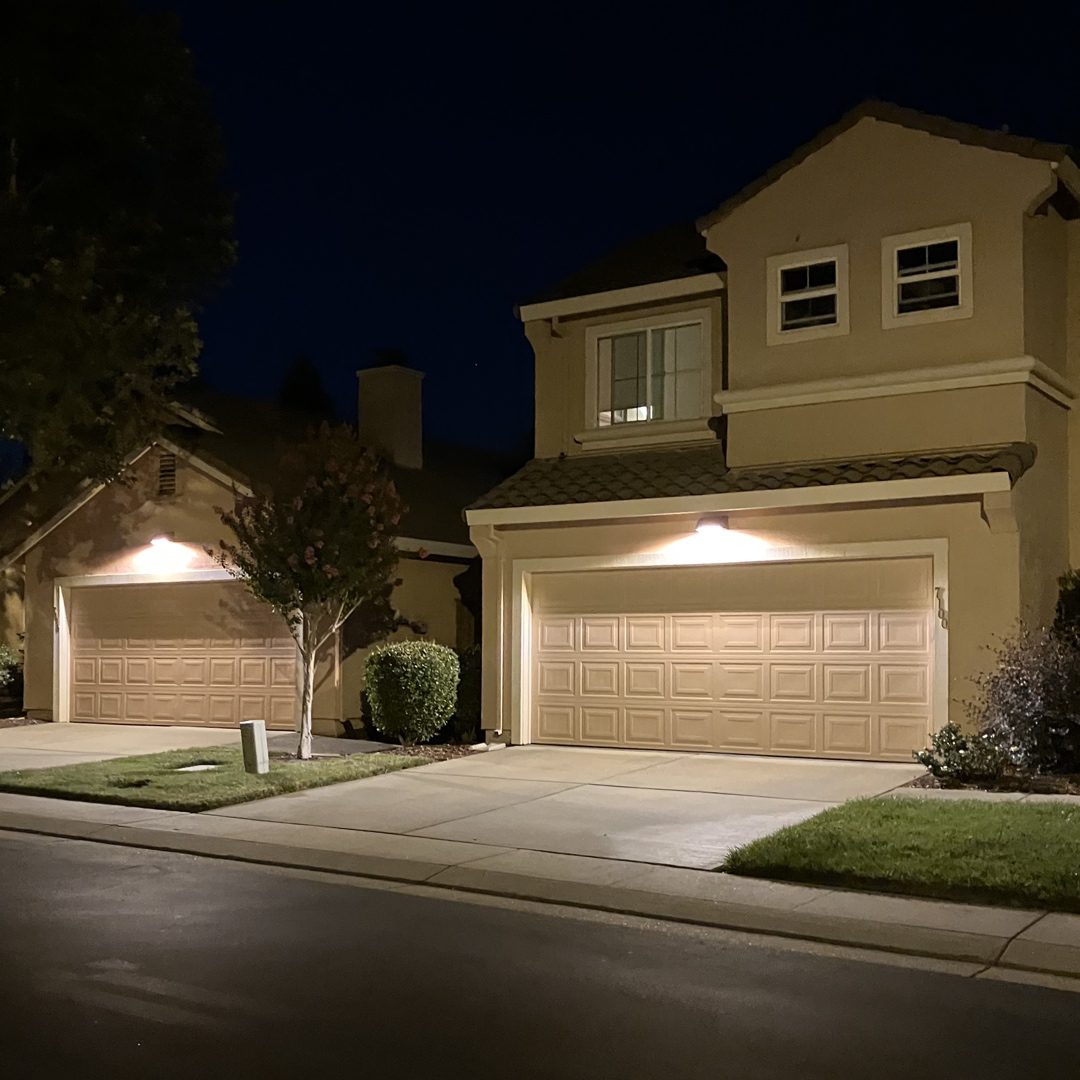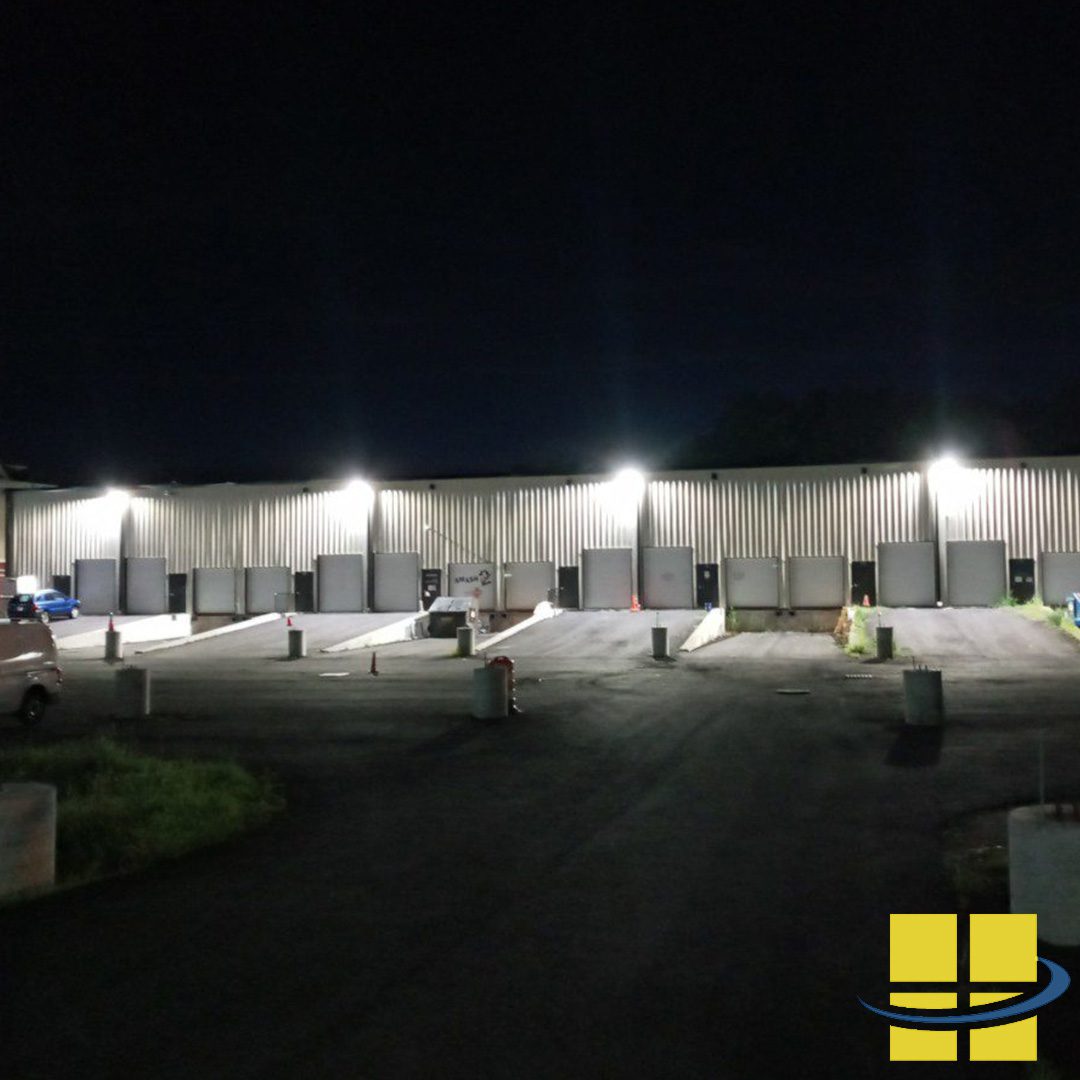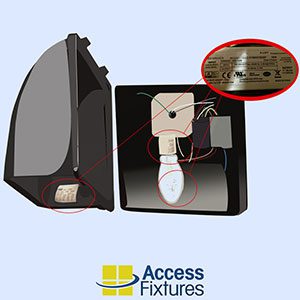
Metal Halide to LED Wall Packs
Switching from a metal halide wall pack to an LED can seem daunting at first. The technologies are so different, that you may be worried about finding a solution that will give you the best results. With a wide range of LED wattages available, it can be hard to determine which wall pack will provide the right lighting for your application. To help you decide, we’ve broken down the steps our lighting specialists use to find equivalent wall pack replacements. If you get lost at any point, don’t hesitate to contact us for more information.
Determine the Wattage of Your Current Metal Halide Wall Pack
Whenever you are replacing a light fixture, it’s important to start with some basic facts. The first figure to have on hand is the current wattage of your existing wall pack. Traditional lighting technologies such as high-pressure sodium (HPS), metal halide (MH), and fluorescent, tend to come in a standard handful of wattages that make it easy to find replacement lamps. The efficiency of LEDs, however, makes wattage an unreliable figure if used alone, but we can still use it as a starting point.
Your existing metal halide should have wattage information written on one of three places: a tag inside the luminaire, the ballast, or somewhere on the lamp itself. For the sake of demonstration, we’ll assume that the wall pack you are starting with is a 250w metal halide with a traditional housing and a color temperature of 4,300K.
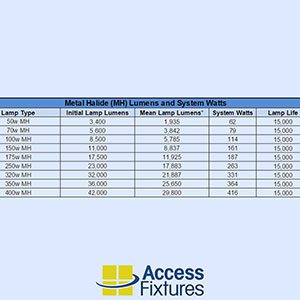
Metal halide lumens and system watts
Find the Mean Lumens of Your Metal Halide Lamp
Mean lamp lumens refers to the average lumen output of a lamp over the course of its functional lifespan. Metal halide and other HID lamp types start with a high initial lumen output that gradually depreciates. To factor for MH lumen depreciation, the mean lamp lumen data point considers the amount of lumens emitted by the lamp after 40% of its rated life. The following table lists the typical mean lamp lumens for many metal halide wattages as well as other data that will be relevant later on.
Using the table, we can see that the mean lamp lumens of a 250w MH wall packs 17,883.
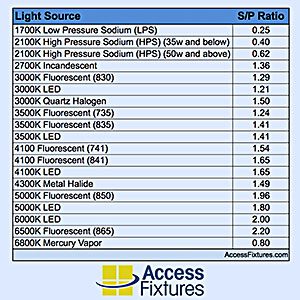
Photopic/Scotopic ratios
Adjust Mean Lumen Output for Actual Visibility (Scotopic vs. Photopic Lumens)
Visual perception has two parts: photopic and scotopic vision. Photopic vision occurs in high light levels and is controlled primarily by our cones; scotopic vision occurs in low light levels and is controlled primarily by our rods. According to the most recent studies, most of our visual perception is actually a combined effort between the rods and cones. We refer to this visual range as the mesopic region.
Our eyes are more sensitive to the color blue, particularly at low light levels. Because of this, the blue-white light of LEDs is frequently criticized for being “too bright.” To find the best lighting, it is important to factor in the ratio between scotopic and photopic lumens, known as the S/P ratio. A lamp with a high S/P ratio will provide clearer light and better color rendering. To find the actual visibility of a luminaire, determine the S/P ratio and multiply it by the mean lumens of the luminaire. Don’t worry, there is no magic trick to this: The ratios are fairly standard and can be found on the chart on the right.
The S/P ratio for a 4300K metal halide fixture is 1.49. Once you have the S/P ratio, finding the visually effective lumens (VELs), also called pupil lumens or usable lumens, is relatively easy. You can estimate VELs by multiplying the mean lamp lumens by the S/P ratio:
17,883 x 1.49 = 26,646 VELs
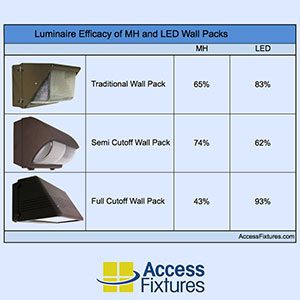
Luminaire efficacy of metal halide and LED wall packs
Calculate the Luminaire Efficacy of Your MH Wall Pack
Luminaire efficacy is a lamp’s measured ability to provide light. To calculate the efficacy of a 250w MH wall pack, divide its emitted lumens by its lamp lumens.
Luminaire Efficacy = Emitted Lumens / Lamp Lumens
The manufacturer of your MH wall pack should have the values for emitted lumens. If you don’t remember the manufacturer, or you don’t feel like reconnecting with them, you can use the following Access Fixtures cheat sheet, “Luminaire Efficacy of MH and LED Wall Packs.”
Note: the housing style of a fixture will affect its efficacy; a traditional wall pack will have greater efficacy than its full cutoff equivalent. For our example, the luminaire efficacy of a metal halide wall pack with a traditional housing is 65%.
Adjusting for Mean Visible Luminaire Lumens of Your MH Wall Pack
Mean visible luminaire lumens is the average number of lumens put out by a wall pack over its lifetime. Simply multiply the VELs we found in step 3 by the total luminaire efficacy we found in step 4.
For a 250w MH wall pack, the equation would look something like this:
26,646 VELs x 65% = 17,320
Calculate Mean Visible Luminaire Lumens for LED Replacement Wall Pack
Once you know the mean visible luminaire lumens for the MH wall pack, you’ll need to find this same figure for an LED wall pack and compare the two. Easy enough, right?
Unfortunately, because of the differences between MH and LED technology, the calculations for LEDs are slightly different. If you’re not sure which LED fixture to start with, a good rule of thumb is to cut the MH wattage in half and use that as a starting point for the ideal LED wattage. By that logic, the closest LED replacement wattage for a 250w MH wall pack would be a 126w unit. We’ll use the 126w High Output LED Traditional Deep Wall Pack as our test. However, this method only provides a “best guess”—after running the following calculations, you’ll want to narrow down the LED wattages to find a more specific match for your needs. Follow these steps to find mean visible luminaire lumens for an LED wall pack:
-
- Determine the initial light source lumens. Most manufacturers will have data on initial light source lumens on record. The 126w LED lamp throws 17,724 initial light source lumens.
- Multiply the initial light source lumens by 85% to get the mean lamp lumens. Keep in mind that LED fixtures sometimes use LED chips instead of lamps; we can use the term mean lamp lumens to refer to both styles. Also, recall our earlier discussion on lumen depreciation; LEDs depreciate far less drastically than MH—so much so that an LED fixture at 85% of its rated life will perform as well as an MH fixture at 40% of its rated life. 17,724 x 85% = 15,065 mean lamp lumens
- Use the S/P ratio chart to select the S/P ratio for the LED wall pack. The S/P ratio for a 4100K LED is 2.04, or 204%.
- Multiply mean lamp lumens by the S/P ratio to find the VELs of the LED fixture. 15,065.4 x 204% = 30,733 VELs
- Use the “Luminaire Efficacy of MH and LED Wall Packs” table to determine the efficacy of the LED fixture. The efficacy of a traditional LED wall pack is 83%.
- Find the mean visible luminaire lumens by multiplying the VELs by the efficacy of the wall pack. 30,733 x 83% = 25,508 mean visible luminaire lumens
Now, we know the mean visible luminaire lumens for both the existing MH and a possible LED replacement. If we look back to step 6, we can remember that the figure for the mean visible luminaire lumens of the 250w MH traditional wall pack was 17,320. The figure for the mean visible luminaire lumens of the 126w traditional wall pack is 25,508.
Finding the Right LED Replacement Wall Pack for You
You are almost ready to shop! If we compare the mean visible luminaire lumens of the two fixtures, we can see that the 126w LED we used in step 6 would provide more light than may be desired. If you’re looking to more closely match the MH fixture you currently have, you’ll likely want to run the numbers of various other LED fixtures to find the best one for you.
When searching through the LED options, keep in mind that a mean visible luminaire lumen variance of +/-10% is nearly undetectable by the human eye. With this in mind, we narrowed our search down to the 81w High Output LED Traditional Deep Wall Pack, which throws 16,398 mean visible luminaire lumens. This figure falls close to the 17,320 mean visible luminaire lumens thrown by the original MH fixture. Remember: if you want to increase light output, run the math with higher-wattage LED fixtures; if you want to decrease light output, run the math with lower-wattage LED fixtures.
We won’t blame you if you don’t have the time or desire to make all these calculations—and that’s why we’re here. Simply enough, we love this kind of work and look forward to helping you navigate the transition from MH to LED. Give us a call at (800) 468-9925 and we’ll find you a solution!
Access Fixtures Lighting Specialists Can Make This Simple
If your wall packs are showing significant signs of age and light degradation, now is the time to upgrade. Access Fixtures is your factory-direct source for high-quality lighting, including T5, PSMH, and LED industrial and warehouse lighting. If you’d rather have an Access Fixtures lighting specialist tell you about it or if you need help placing an order, call us at 800-468-9925. Our customer service team is located in Worcester, MA, and is ready to get you the fixtures you need.

